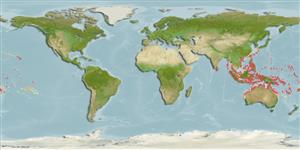>
Acanthuriformes (Surgeonfishes) >
Chaetodontidae (Butterflyfishes)
Etymology: Chaetodon: Greek, chaite = hair + Greek, odous = teeth (Ref. 45335).
Eponymy: Sir Thomas Stamford Bingley Raffles (1781–1826) was a colonial officer, Lieutenant-Governor of Java (1811–1815) and founder of the city-state of Singapore (1819). [...] (Ref. 128868), visit book page.
Environment: milieu / climate zone / depth range / distribution range
Ecología
marino; salobre asociado a arrecife; rango de profundidad 0 - 15 m (Ref. 1602). Tropical; 32°N - 31°S, 77°E - 130°W
Indo-Pacific: Sri Lanka to the Tuamoto Islands, north to southern Japan, south to the Great Barrier Reef; Palau (Belau) to the eastern Caroline Islands in Micronesia.
Tamaño / Peso / Age
Maturity: Lm ? range ? - ? cm
Max length : 18.0 cm TL macho / no sexado; (Ref. 48636); common length : 15.0 cm TL macho / no sexado; (Ref. 48636)
Espinas dorsales (total) : 12 - 13; Radios blandos dorsales (total) : 21 - 23; Espinas anales: 3; Radios blandos anales: 18 - 20. Body color is yellow with cross-hatched pattern on the sides. A dark black spot is sometimes present under the spinous portion of the dorsal fin. A black bar runs across the eye. The dorsal, anal and caudal fins have a dark stripe the position of which varies with age (Ref. 4855). Snout length 2.1-2.6 in HL. Body depth 1.4-1.8 in SL (Ref. 90102).
An uncommon species found in areas of rich coral growth of lagoon and protected reef flats and seaward reefs (Ref. 9710). Often in pairs (Ref. 9710, 48636). Feed on sea anemones, polychaetes, and octocorallian and scleractinian coral polyps. Oviparous (Ref. 205). Form pairs during breeding (Ref. 205). In captivity, this species should be fed algae stones and the so-called 'feeding stones' which are prepared by spreading the food pulp over the stone. Minimum depth reported taken from Ref. 128797.
Life cycle and mating behavior
Madurez | Reproducción | Puesta | Huevos | Fecundidad | Larva
Distinct pairing (Ref. 205).
Myers, R.F., 1991. Micronesian reef fishes. Second Ed. Coral Graphics, Barrigada, Guam. 298 p. (Ref. 1602)
IUCN Red List Status (Ref. 130435: Version 2024-2)
Threat to humans
Harmless
Human uses
Pesquerías: escaso valor comercial; Acuario: Comercial
Herramientas
Special reports
Download XML
Fuentes de Internet
Estimates based on models
Preferred temperature (Ref.
123201): 25.1 - 29.3, mean 28.6 °C (based on 2681 cells).
Phylogenetic diversity index (Ref.
82804): PD
50 = 0.5000 [Uniqueness, from 0.5 = low to 2.0 = high].
Bayesian length-weight: a=0.02291 (0.01133 - 0.04632), b=3.00 (2.83 - 3.17), in cm total length, based on LWR estimates for this Genus-body shape (Ref.
93245).
Nivel trófico (Ref.
69278): 4.3 ±0.0 se; based on diet studies.
Resiliencia (Ref.
120179): Alto, población duplicada en un tiempo mínimo inferior a 15 meses (Preliminary K or Fecundity.).
Fishing Vulnerability (Ref.
59153): Low vulnerability (10 of 100).
Nutrients (Ref.
124155): Calcium = 88.7 [43.0, 172.9] mg/100g; Iron = 0.725 [0.395, 1.299] mg/100g; Protein = 19.4 [18.2, 20.5] %; Omega3 = 0.133 [0.075, 0.238] g/100g; Selenium = 24 [12, 50] μg/100g; VitaminA = 58 [15, 228] μg/100g; Zinc = 1.33 [0.84, 2.00] mg/100g (wet weight);
